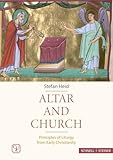Altar and Church : principles of liturgy from early Christianity / Stefan Heid.
Material type: TextLanguage: English Original language: German Publisher: Regensburg : Schnell + Steiner ; Washington, D.C. : The Catholic University of America Press, 2023Edition: First editionDescription: 512 pagine : illustrazioni, piante; 25 cmContent type:
TextLanguage: English Original language: German Publisher: Regensburg : Schnell + Steiner ; Washington, D.C. : The Catholic University of America Press, 2023Edition: First editionDescription: 512 pagine : illustrazioni, piante; 25 cmContent type: - testo (txt)
- senza mediazione (n)
- volume (nc)
- 9783795438456
- 9780813237435
- Altar und Kirche. Inglese
- BQT 4026.H34 2023
| Item type | Current library | Call number | Status | Barcode | |
|---|---|---|---|---|---|
 Opera (Magaz.)
Opera (Magaz.)
|
Biblioteca "Angelicum" Pont. Univ. S.Tommaso d'Aquino Temporary Library | BQT 4026.H34 2023 (Browse shelf(Opens below)) | Available | 0030221864 |
Bibliografia: pagine 477-493.
This is the first English edition of a book first published very successfully in German in 2019. It is a translation of the revised third German edition. The central themes of Stefan Heid’s book are the early Christian altar and the design and building of churches. It is about the beginnings of the Christian liturgy; but it is also about the principles behind the liturgy. -- In his Preface, the author states that the book is concerned with “those things that are so fundamental and important for Christian worship that up to the Middle Ages they were found in all churches and to this day continue to exert an influence, especially in the communities of the East. In many cases, however, the praxis has meanwhile diverged a long way from what it once was and is now increasingly subject to ideological decisions.” Since the liturgical reform of the Vatican Council 2, the altar has been at the centre of many redesigns of Catholic church spaces, with the early Church frequently taken as the model. But how can this be reconciled with the widespread opinion that Christianity initially knew no cult and no sacrifices? It was not until later, from the time of Emperor Constantine, that a real state-supported cult with sacrifices, altars and magnificent sacred spaces developed; the Church suffers from this historical burden to this day. This volume carves a few paths through the liturgical jungle and arrives at results that are as surprising as they are stimulating.


